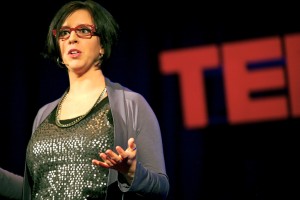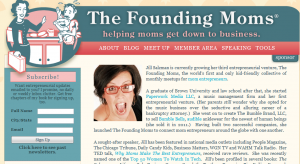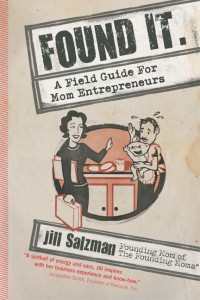The Challenges of Self-Publishing – And Why I’d Do It Again
With a publisher, fame and fortune would certainly follow. Right?
The idea for Found It: A Field Guide for Mom Entrepreneurs came to me in the night. Literally. At 2 AM, I raced to a lined yellow pad and each of the 51 chapters fell out of my head and onto the paper. Just like that. Ten minutes flat. I knew it was something that the members of my organization, The Founding Moms, needed to read. They would buy it, but how would I get it into their hands?
Find an agent. That’s what everyone told me to do. Seek out a representative who would push my book hard, and the right publisher would make a great offer. So, I headed to the nearest Borders (may it rest in peace) and picked up a magazine on publishing. An agent was interviewed about how many submissions she gets, why she can’t respond to most of them, and why writers shouldn’t even bother contacting her. So I emailed her. She responded almost immediately and because she did, I was off and running.
Proposal in hand, my new agent shopped it around to publishers big and small. She bragged about the organization that I run and just how many members we had who would buy the book. See, I run The Founding Moms. It’s a collective of meetups for mom entrepreneurs in 30+ cities around the globe. In under 2 years we’ve grown to 2,500+ members. Women business owners come together once a month to help each other build better businesses. It’s a platform that I did not intend to build — it’s very much member-driven — but it’s the kind of platform that publishers pray their authors already have. A built-in audience for a new book? That’s a base of buyers ready to go.
Did this help? Apparently not.
Instead of taking a look at who I was and what my membership base comprises, the publishers compared and contrasted my book idea to recent business book releases and how they performed. To this day, I strongly believe that my book is unlike any other in its field. (Of course I do.) No matter: all offers that my glorious agent received were junk. No real bites. But I sat. And waited. And waited some more.
One day, a whole year later, it occurred to me that I help, advise and educate entrepreneurs day in and day out. If I was all about DIY, I may as well DIM (Do It Myself.) Self-publishing, albeit praised all over the Internet, was not something people talked about much in my circles. Mostly because no one had any experience with it. I sought advice from a few self-published authors but no one seemed to be truly enthusiastic about it. I talked to local bookstore owners about self-published authors and they responded with, “Goooooooooood luck with that one. Tough stuff. Hope you make it!”
As with any company I’ve launched, I started from scratch.
I asked around for recommendations of graphic designers, of book editors, of book designers and of printers. I amassed lists and queries and quotes. Turns out all that inquiring, collecting and sifting is fun in and of itself. It’s not exactly what an author signs up to do, but it’s a start to realizing just how much control you have over the entire process. I’d heard horror stories from published authors who didn’t even choose the titles to their own books. That would never happen to me. And it was then that I became a convert. Suddenly, I was self-publishing’s biggest advocate and hardest-working author.
Thanks to my built-in audience, I knew what appealed to them. I wanted to keep the cover of my book in line with my brand, and the end-result was a very cool, funked-up version of my website at FoundingMoms.com, which you can see here.
The book designer and I worked very closely together, literally designing page by page, so that the look and feel of the book matched my expectations and that of my potential readers. The illustrator happens to live across the street from where I do, and his cartoons are hysterical — and very well-received on Facebook. The book designer recommended the printer who did a fantastic job.
And my editor? She was recommended by a mutual friend and it turns out she’s the best editor I’ve ever had. (I do write for NBC Chicago and the New York Times so I’ve had an editor or two previously.) By the end of the entire process, I had a new family to whom I felt indebted and so grateful that they’d worked so hard on my wordbaby. Although I’m a writer, turns out I’m also a self-publishing addict because I dearly miss the days of going back-and-forth with my literary family and tweaking my work to perfection.
How do I distribute the book? A local bookstore owner tipped me off to a fantastic distributor, Small Press United (SPU), which is a part of major distributor IPG. I created a publishing company, Piggott Press, applied to SPU and was accepted. They take a percentage far less than a publisher ever would, and they get my book into the hands of any and every indie bookstore and national chain that there is.
To those of you seeking a publishing deal: quit it. You don’t need to hand over any profits, control, distribution or happiness to a major corporation that may or may not pay attention to your success anyhow. Go the way of T.S. Eliot, Thomas Hardy, Stephen King, Rudyard Kipling, Ernest Hemingway, Upton Sinclair, Virginia Woolf, Walt Whitman, Mark Twain and Edgar Allen Poe. I’ve found much success in self-publishing, and you can, too.
—
Jill’s TED Talk: http://www.bitly.com/jillsted
Jill’s book: Found It: A Field Guide for Mom Entrepreneurs
Category: Contemporary Women Writers, Growing Your Platform, How to Get Published, Independent Publishing, On Publishing, US American Women Writers
Comments (11)
Trackback URL | Comments RSS Feed
Sites That Link to this Post
- The Challenges of Self-Publishing - And Why I'd... | April 5, 2014







Well done Jill! I like your story. I think self-publishing authors are driven by a certain entrepreneurship and passion. They should obtain a higher recognition they deserve. They have the guts to invest in their dream and they make it happen. Somehow I had the illusion entrepreneurs and self-publishing authors would get more respect or rewarding in the States comparing to my country The Netherlands. I am afraid it is the same everywhere in the world. I am shocked that your agent could not find a publisher who was interested in your book or network.
Knowing that you have a niche market of readers and a way of distributing is so important. As an Australian writer ,I publish with major, mainstream international publishers but I also have my own e-books from my website for specialised literacy or Antarctic subjects. Persistence and the opportunity to be accessible internationally makes an author website even more important than a blog. Congratulations on your achievement.
Thanks very much, Hazel. Much appreciated and I hope to check out your e-books shortly!
Jill —
This is an excellent article and I hope your readers take it to heart. At age 60 I decided to stop “accepting” rejections of my novel MRS. LIEUTENANT and take control into my own hands.
I already had a nonfiction book traditionally published and knew that, in either case, I would have to do the marketing. And by self-publishing (as you said) I could get the cover I wanted, rather than the cover for SEASONS FOR CELEBRATION that to this day I do not particularly like. (Nor do I like the publisher-chosen book title.)
One thing I would like to add to the information in your post:
I believe it is very important to have a physical and an ebook version of any book in order to make it as easy as possible for readers to buy your book.
Your blog post readers might be interested in the guest post I just wrote for THE INDIE TIMES on DIY ebook conversion — http://www.theindietimes.com/2012/05/diy-ebook-conversion/
Thanks for sharing your experience. I’ve got some big decisions ahead, and this reinforces my intuition.
Cheers!
Jill,
Thank you so very much for writing this fun post for us. You’re a dynamo and it’s exciting to see your creativity and vision at work.
-Anora
Are you kidding? Thanks so much for posting!! I’m thrilled to be a part of your wonderful site. All the best!
Hi Jill! I was wondering if you could share some figures with us all here. I, too, went the self-publishing route and have yet to make back the investments I’ve made on both of my self-published titles. Maybe it’s a bit different because you did have that built in community that so few self-pubbed writers do. Do you think it’s necessary to start your own publishing company to get your book into stores? Thanks! A.J.
Hey A.J.!
I created the self-publishing company in the hopes of nabbing a distributor. That’s the only reason. I’d assumed distributors want to see more than one book in the pipeline (and I do have more books in the works.) Whether it was necessary, I don’t know, but I did secure a distributor and it’s been much easier for indie bookstores to purchase books through wholesalers. Would have been a LOT more work for me if I did it all myself. I’m all about going DIY but just wanted a bit of help since I’m very new to publishing myself.
Did that answer your Q?
Thanks for posting! Very informative. How have you done going through Small Press United? I hadn’t heard of them before.
Until my book is published, I’ve signed up for expanded distribution on Createspace, but I’d also considered IngramSpark, and now I know about SPU. I’m still not sure if this is the way to go. Does anyone have any experience with one versus the other?
I’m much more enthusiastic about getting my book into bookstores if I can, but have no clue if one might be better than the other for doing that. I see SPU wants exclusivity, is why I’m asking.
Thanks!
Laini